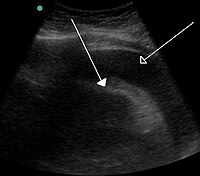
Photo from wikipedia
Superior vena cava (SVC) syndrome results from the blockage of venous blood flow through the SVC, which is caused by either internal obstruction (eg, thrombus) or external compression (eg, thoracic… Click to show full abstract
Superior vena cava (SVC) syndrome results from the blockage of venous blood flow through the SVC, which is caused by either internal obstruction (eg, thrombus) or external compression (eg, thoracic malignancy and infection).1 While thrombus-related SVC syndrome is rising in prevalence, malignancy still accounts for the majority of cases.1 Regardless of cause, SVC syndrome is characterised by facial swelling and plethora, headache and dyspnoea.2 Although venous stenting has become standard of care for treatment of acute SVC syndrome, stent placement presents multiple risks including SVC rupture and cardiac tamponade. In these cases, a high index of suspicion and prompt action are required to avoid an often fatal outcome. Here, we present the case of a patient with cardiac tamponade and subsequent cardiac arrest after SVC stent placement.
Journal Title: BMJ Case Reports
Year Published: 2020
Link to full text (if available)
Share on Social Media: Sign Up to like & get
recommendations!